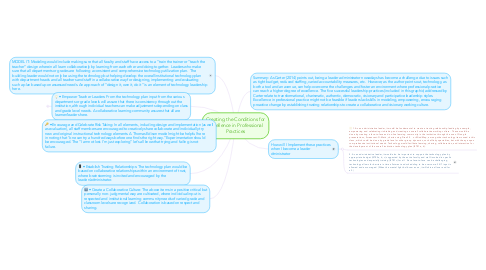Creating the Conditions for Excellence in Professional Practices
by JAET Oaktree

1. MODEL IT: Modeling would include making sure that all faculty and staff have access to a “train the trainer or “teach the teacher” design wherein all learn collaboratively by learning from each other and doing together. Leaders who make sure that all departments or grades are following a consistent and comprehensive technology utilization plan. The building leader would not only be using the technology but helping develop the overall institutional technology plan with department heads and all teachers and staff in a collaborative way for designing, implementing and evaluating such a plan based upon assessed needs. An approach of “design it, own it, do it” is an element of technology leadership here.
2. • Empower Teacher Leaders: From the technology plan input from the various departments or grade levels will assure that there is consistency throughout the institution, although individual teachers can make adjustments depending on class and grade level needs. A collaborative learning community assures that all are learner/leaders here.
2.1. Tutorial Videos
2.2. Advanced
2.2.1. Open the Theme menu from the bottom of your map editor to change your map theme
2.2.2. Create a presentation of your mind map by clicking the presentation icon in the bottom left corner of your screen
2.2.2.1. Simply hold down COMMAND i.e. CTRL and Click & Drag to create a slide for one or multiple topics
2.2.2.2. Set transitions for your slides
2.2.2.3. Click "Start Slideshow" to view your presentation
2.2.3. Open the Sharing Settings from the bottom of your map editor to share the map with a friend or publish it to the web
2.2.3.1. You can share your map with anyone via email
2.2.3.2. You can publish your map and enable anyone with an internet access to find it
2.2.3.3. You can embed your map on a blog or website
3. • Encourage and Celebrate Risk Taking: In all elements, including design and implementation (as well as evaluation), all staff members are encouraged to creatively share collaborate and individually try new and original instructional technology elements. A Thomas Edison model might be helpful here in noting that “one can try a hundred ways before one finds the right way.” Experimentation should be encouraged. The “I am not lost. I’m just exploring” let’s all know that trying and failing is not failure.
4. • Establish Trusting Relationships: The technology plan would be based on collaborative relationships within an environment of trust, where brainstorming is invited and encouraged by the leader/administrator.
5. • Create a Collaborative Culture: The above items in a positive critical but personally non- judgmental way are cultivated, where individual input is respected and institutional learning community needs of varied grade and classroom levels are recognized. Collaboration is based on respect and sharing.
6. Summary: As Carter (2014) points out, being a leader administrator nowadays has become a challenge due to issues such as tight budget, reduced staffing, varied accountability measures, etc. However, as the author points out, technology, as both a tool and an avenue, can help overcome the challenges and foster an environment where professional practice can reach a higher degree of excellence. The five successful leadership practices (included in this graphic) addressed by Carter relate to transformational, charismatic, authentic, democratic, visionary and participative leadership styles. Excellence in professional practice might not be feasible if leaders lack skills in modeling, empowering, encouraging proactive change by establishing trusting relationships to create a collaborative and visionary working culture.
7. How will I Implement these practices when I become a leader dministrator
7.1. 1. As an administrative leader, it would be fundamental to create a trusting relationship leading by example, empowering and celebrating risk-taking and creating an overall collaborative working culture. These would be done by creating a face-to-face and on-line learning community in the institution through the use of Google presentations, Screencast-O-Matic, charts using Draw10 or MindMap, among other technology items used in this class, which could be done by grade level or other group dynamics, such affinity specialties, but with the eye upon comprehensive institutional needs. Technology would facilitate learning, sharing, collaboration, and interaction for the development of the overall institution technology plan (ISTE1a, b).
7.2. 2. As an administrative leader, it would also be important to support the technology plan by appropriate budget (ISTE3a, b, c) suggested by the entire faculty and staff involved in specific technologies and especially training (ISTE1c) for all. Since face-to-face can be challenging, technology allows for barriers in time allotment and scheduling to be overcome. 24/7 input is allowed and encouraged. (When the mental light bulb comes on, it will shine all over and for all.)


